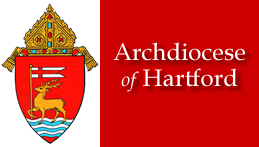 |

|
Conference of Deacons
|
What is it?
The Conference of Deacons is composed of all deacons in the Archdiocese of Hartford. Deacons are members simply by virtue of their ordination.
You cannot not be a member. Participation, though, is completely optional.
What is the structure of the Conference?
The reporting structure of the diaconate looks like this:
- Archbishop
- Council of the Conference of Deacons (CCOD)
- The CCOD is composed of deanery leadership
- CCOD leadership is elected by CCOD members for two-year terms
- Deanery Leadership
- Deacons
What is the mission of the CCOD?
The mission of the CCOD is twofold:
- To advise deacons about what's going on in the life of the
larger church that affects them.
- To propose projects to be undertaken to address issues and opportunities that affect the diaconate in general. With the approval of the archbishop,
projects are launched and managed to conclusion. Current projects are:
- Vocations
- Spirituality
- Deanery Revitalization - stay tuned!
The CCOD has no directive authority with regard to any particular deacon.
Its role is simply to be an information conduit and a project management resource.
What can the CCOD do?
The CCOD can:
- Disseminate information to deanery leadership, and to collect it from the deacons in their deaneries.
- Help deacons implement the principal of subsidiarity. This term means that the church addresses its issues at the lowest level at which they can be
properly addressed. If resolution cannot be had, the issues is passed up the hierarchy. If an issue or opportunity has impact or applicability beyond the local venue, deacons may choose to present the issue or opportunity
to the Vicor for Clergy through the CCOD. This simply means that other deaneries get to look at the item too, instead of it being a private conversation or no conversation at all. It's left to the judgment of the deacon(s) who want to raise the issue or opportunity whether a direct or a broad approach would be most suitable.
- Manage projects. The CCOD has access to excellent project management skills and has a small budget. It can get things done.
- CCOD members act as liaison between the diocesan deacon organization and the National Association of Diaconate Directors (NADD).
What can the CCOD not do?
The CCOD cannot:
- Intervene to solve local problems
- Change diaconate policy all on its own
- Authorize expenditures or activities aside from its own
- Reassign y ou, or provide input to that process
- Make Vicar for Clergy or the archbishop, do anything
How do I get to be on the CCOD?
Become a deanery leader. Then you're on the CCOD whether you like it or not!
I'm not a deanery leader, but I have something to say. How do I deal with this group?
Your voice is important, and there are a number of ways to have it heard. You can:
- Show up at ameetingse days we're using Zoom. All deacons are always welcome. We follow Robert's Rules of Order and expect attendees to honor the process.
- Comment on the minutes by e-mail, phone, USPS mail or in person
- Talk to your deanery leader and have him bring your thoughts forward
- Call or e-mail the CCOD president (Dcn.Ryzewski@AOHCT.org)
In short, if you want to share an idea, raise an issue, spread some news of general interest, offer something good (workshops, spiritual resource,
ministry tips...) to your brother deacons and their families, think of the CCOD as a way to get it done.
For What It's Worth...
Some thoughts and issues that have been raised in the past have generated no traction in the diocese, and frankly never will. To avoid frustration,
we offer a few examples to you in the spirit of brotherly love:
- Assuming clerical dress (Roman collars, birettas...)
- Changing Canon Law so we can perform the Sacrament of the Sick or transubstantiate
- ...any other modification that crosses the boundary between what it means to be a priest and what it means to be a deacon
|